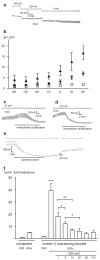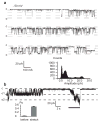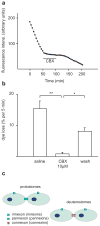Innexins form two types of channels
- PMID: 18035059
- PMCID: PMC2489203
- DOI: 10.1016/j.febslet.2007.11.030
Innexins form two types of channels
Abstract
Injury to the central nervous system triggers glial calcium waves in both vertebrates and invertebrates. In vertebrates the pannexin1 ATP-release channel appears to provide for calcium wave initiation and propagation. The innexins, which form invertebrate gap junctions and have sequence similarity with the pannexins, are candidates to form non-junctional membrane channels. Two leech innexins previously demonstrated in glia were expressed in frog oocytes. In addition to making gap junctions, innexins also formed non-junctional membrane channels with properties similar to those of pannexons. In addition, carbenoxolone reversibly blocked the loss of carboxyfluorescein dye into the bath from the giant glial cells in the connectives of the leech nerve cord, which are known to express the innexins we assayed.
Figures



References
-
- Sigurdson WJ, Sachs F, Diamond SL. Mechanical perturbation of cultured human endothelial cells causes rapid increases of intracellular calcium. Am J Physiol. 1993;264:H1745–752. - PubMed
-
- Osipchuk Y, Cahalan M. Cell-to-cell spread of calcium signals mediated by ATP receptors in mast cells. Nature. 1992;359:241–244. - PubMed
Publication types
MeSH terms
Substances
Grants and funding
LinkOut - more resources
Full Text Sources
Miscellaneous

